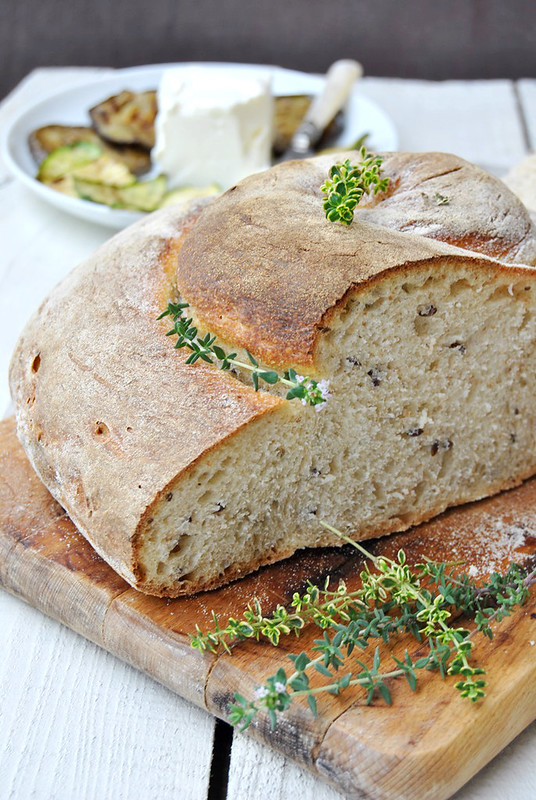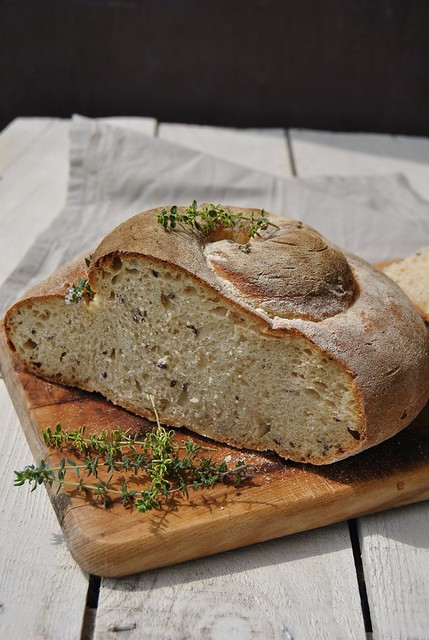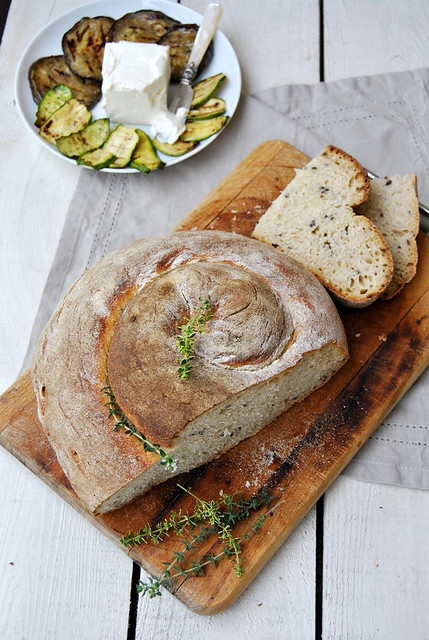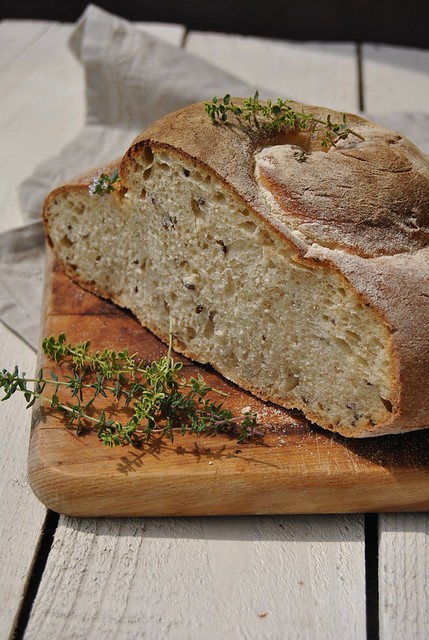Kamut Khorasan Flour Sourdough Bread
 |
The kid's become more than a handful of work. It would take more than one person to keep him under control, and I'm alone with him most of the day. He's a constant menace. I jokingly say that he's able to make more disorder in just 5 minutes than his sisters did in 10 years.
The point is, what I manage to prepare while he's having a nap, becomes an odyssey to write when he's awake. This is just to apologize with my readers that asked for and were promissed the recipe for this beautiful and delicious bread.
However, what I liked about this bread is the shape (that I visually remembered seeing somewhere, a food magazine probably), the taste and the incredibly soft interior (believe me, it's still soft today, on the 5th day).
Therefore, I'm proud and happy to share this recipe with everyone.
Happy baking and have a great weekend.
Kamut Khorasan Flour Sourdough Bread
with flaxseed and fresh thyme
* 400 g Kamut Khorasan flour
* 100 g whole wheat flour
* 150 g sourdough starter (with 50% hydratation)
* 15 g flaxseed
* 400 g water
* 1 teaspoon of barley malt syrup
* 1 TBspoon extra virgin olive oil
* 5-6 fresh thyme twigs
* 12 g salt
Refresh your sourdoguh starter 4-6 hours before you start preparing bread.
Slightly warm up the extra virgin olive oil and add the thyme leaves. Leave them in infusion for at least a couple of hours or overnight.
Put the flaxseed and 350 g of water in a saucepan, and bring to a boil. Lower the heat and let simmer for 5 minutes. Remove from heat and set aside to cool down.
Tear the sourdough starter into pieces and put in a bowl with 50 g of water and the barley malt syrup. Let it soften in water for 10-15 minutes then dissolve completely whisking it.
Put the flours into the bowl of the stand mixer. Add the flaxseed with all the liquid (that turned into mucilage, by the way), the oil with thyme leaves and start mixing everything with the paddle attachment. When all the flour has been absorbed add the salt and switch to the hook attachment. Knead for about 10 minutes, until the dough is smooth and soft.
Cover the bowl and let the dough rest for 10 minutes.
Transfer the dough to a lightly floured kneading board. Flatten it gently with your hands to form a square. Fold the upper third of the square towards the center and then the lower one to cover it.
Repeat folding from right and left to the center. Turn the dough in a way that the seal underneath, place it in a clean bowl and seal with a plastic wrap. Let the dough rise for 3-4 hours or until doubled in size.
Repeat the folding one more time and let it rest again for 1 hour.
Roll the dough with your hands to form a rope and coil it.
Place the bread on a piece of well floured baking paper, dust it with flour, cover and let rise for about 1 hour.
In the meantime
In the meantime, preheat the oven to 250°C, together with the baking stone or a baking tin if you don't have a baking stone. Make sure the stone is heated well (not less than half an hour).
Slide the bread onto the baking stone (together with the baking paper it's been resting on), immediately throw 5-6 ice cubes to the bottom of the oven and close the door quickly.
It's important to bake bread with the steam in during the first 15 minutes as this will allow the dough to expand and rise as the surfice will stay soft. It will also give you nice crunchy crust when finished baking, not that hard, cookie like crust you'd normally get if baking bread without steam.
After the first 15 minutes, lower the heat to 200°C, and after 10 minutes to 180°C. Finish baking the bread after 15-20 minutes. If you like the crust to stay a bit harder and crunchier, after you've turned the oven off, put the bread up against the side of the oven and leave it in for 10-15 minutes, with the oven door slightly open to allow it to dry well.
Take the bread out of the oven and let it cool completely on a cooling rack before cuttin it.
Pane di farina di kamut a lievitazione naturale
con semi di lino e foglie di timo
* 400 g di farina di grano khorasan kamut
* 100 g di farina integrale di grano
* 150 g di lievito madre (idratato al 50%)
* 15 g di semi di lino
* 400 g di acqua
* 1 cucchiaino di malto d'orzo
* 1 cucchiaio di olio extravergine d'oliva
* 5-6 rametti di timo fresco
* 12 g di sale
Rinfrescate il lievito madre 4-6 ore prima di iniziare a impastare il pane.
Scaldate leggermente l'olio d'oliva, aggiungete le foglioline di timo e lasciate in infusione per un paio d'ore.
Mettete a cuocere i semi di lino in 350 g d'acqua. Quando l'acqua inizia a bollire, abbassate la fiamma e lasciate sobbollire per 5 minuti. Lasciateli intiepidire.
Spezzettate il lievito madre e mettetelo in una ciotola con 50 g d'acqua aggiungendo anche il malto d'orzo. Lasciate ammorbidire il lievito per 10-15 minuti, poi mescolatelo con una frusta a mano fino a scioglierlo completamente.
Mettete le farine nella ciotola della planetaria e mescolatele. Aggiungete i semi di lino con la mucillagine, il lievito madre e l'olio d'oliva con le foglioline di timo. Iniziate ad impastare con la foglia fino ad idratare completamente la farina. Aggiungete alla fine il sale. Montate il gancio e continuate ad impastare per una decina di minuti, ribaltando l'impasto un paio di volte, finché diventi liscio e morbido.
Coprite la ciotola e lasciate riposare l'impasto per 10 minuti.
Fate un giro di pieghe a tre: stendete l'impasto con le mani sulla spianatoia leggermente infarinata formando un quadrato. Piegate il terzo superiore verso il centro, e chiudetelo con il terzo inferiore. Nello stesso modo piegate il lato destro e quello sinistro. Arrotondate quindi l'impasto e mettetelo a lievitare in una ciotola pulita, sigillata con la pellicola per 3-4 ore.
Fate un altro giro di pieghe a tre e lasciate lievitare di nuovo per 1 ora.
Formate un lungo filoncino con l'impasto e arrotolatelo su se stesso formando una chiocciola.
Sistemate il pane su un pezzo di carta da forno cosparso con la semola rimacinata e lasciate lievitare coperto per 1 ora.
Nel frattempo scaldate il forno a 250°C. Se usate la pietra refrattaria scaldatela insieme al forno, altrimenti potete scaldare una teglia.
Trasferite il pane nel forno ben caldo e buttate 5-6 cubetti di ghiaccio sul fondo del forno, in modo da avere il vapore durante i primi 15 minuti di cottura che permetterà al impasto di espandersi prima che la crosta si indurisca.
Dopo i primi 15 minuti, abbassate la temperatura a 200°C e dopo altri 10 minuti a 180°C. Lasciate cuocere il pane per altri 15-20 minuti. Se vi piace la crosta più dura e croccante lasciatelo nel forno spento e leggermente aperto, appoggiato sulla parete del forno per altri 10-15 minuti.
Sfornatelo e lasciatelo raffreddare su una grata coperto con un panno pulito.
Tagliatelo soltanto quando si sarà raffreddato completamente.
Kruh od kamuta s kvasom
sa sjemenkama lana i listićima timijana
* 400 g brašna od kamuta khorasan
* 100 g integralnog pšeničnog brašna
* 150 g kvasa/startera (sa 50% hidratacijom)
* 15 g sjemenki lana
* 400 g vode
* 1 žličica ječmenog slada
* 1 žlica ekstra djevičanskog maslinovog ulja
* 5-6 grančica svježeg timijana
* 12 g soli
Kvas nahranite 4-6 sati prije nego ćete zamijesiti kruh.
Lagano zagrijte maslinovo ulje, pa dodajte listiće timijana. Ostavite ih u infuziji par sati (ili pripremite dan ranije).
Stavite kuhati sjemenke lana u 350 g vode. Kad voda provrije, smanjite vatru i ostavite da lagano kuha 5 minuta. Maknite s vatre i ostavite da se umlači.
U preostalih 50 g vode nakidajte kvas/starter, ostavite da omekša u vodi 10-15 minuta uz dodatak ječmenog slada. Zatim ručnom pjenjačom miješajte dok se kvas potpuno ne istopi.
U zdjelu stolnog miksera stavite obje vrste brašna i izmiješajte rukom. Dodajte umlačene sjemenke lana s vodom u kojoj su se kuhale i koja se hlađenjem pretvorila u sluz, kvas i ulje s listićima timijana. Mijesite prvo s lopaticom. Kad su se sastojci povezali, dodajte sol.
Zamijenite lopaticu kukastim nastavkom za tijesta i mijesite 10-ak minuta (tijekom kojih par puta zaustavite mikser i preokrenite tijesto) dok tijesto nije glatko i podatno.
Pokrijte zdjelu i ostavite tijesto da odmori 10-ak minuta.
Premjestite tijesto na sasvim malo pobrašnjenu dasku i preklopite ga na trećine: lagano rukama rastanjite tijesto na kvadrat, preklopite gornju trećinu prema sredini, a zatim donju trećinu preko nje; preklopite desnu trećinu prema sredini, a zatim lijevu preko nje. Zaokružite rukama tijesto u loptu i stavite u čistu zdjelu. Pokrijte poklopcem ili prozirnom folijom i ostavite na toplom oko 3-4 sata.
Preklopite tijesto nakon dizanja još jedanput i ostavite da se diže opet 1 sat.
Oblikujte tijesto u dugu rolnicu i smotajte je poput puža.
Stavite tijesto na komad papira za pečenje obilno posut brašnom. Pospite kruh brašnom odozgor i ostavite ga da se diže 1 sat.
U međuvremenu zagrijte pećnicu na 250°C. Ako pečete kruh na kamenu zagrijte ga dobro zajedno s pećnicom. Ako nemate kamen zagrijte pleh na kojem ćete peći kruh.
Premjestite kruh u pećnicu na vruć kamen ili pleh (zajedno s papirom, koji nakon prvih 15 minuta možete izvući ispod kruh i ukloniti). Prije nego zatvorite pećnicu ubacite na dno 5-6 kocki leda (para će pomoći da se ne stvori odmah tvrda kora na površini, na taj način će se tijesto lakše širiti i bolje narasti, a kasnije ćete imati krckavu ali ne tvrdu koricu).
Nakon 15 minuta (kad kruh počne dobivati boju), smanjite temperaturu na 200°C, i nakon još 10 minuta na 180°C. Pecite kruh još 15-ak do 20 minuta (ne brinite ako vam se čini da je kora tvrda, odmeknut će kasnije).
Ostavite kruh da se ohladi na rešetki pokriven čistom platnenom krpom. Režite kruh tek kad se potpuno ohladio.
 |
However, what I liked about this bread is the shape (that I visually remembered seeing somewhere, a food magazine probably), the taste and the incredibly soft interior (believe me, it's still soft today, on the 5th day).
Therefore, I'm proud and happy to share this recipe with everyone.
Happy baking and have a great weekend.
 |
with flaxseed and fresh thyme
* 400 g Kamut Khorasan flour
* 100 g whole wheat flour
* 150 g sourdough starter (with 50% hydratation)
* 15 g flaxseed
* 400 g water
* 1 teaspoon of barley malt syrup
* 1 TBspoon extra virgin olive oil
* 5-6 fresh thyme twigs
* 12 g salt
Refresh your sourdoguh starter 4-6 hours before you start preparing bread.
Slightly warm up the extra virgin olive oil and add the thyme leaves. Leave them in infusion for at least a couple of hours or overnight.
Put the flaxseed and 350 g of water in a saucepan, and bring to a boil. Lower the heat and let simmer for 5 minutes. Remove from heat and set aside to cool down.
Tear the sourdough starter into pieces and put in a bowl with 50 g of water and the barley malt syrup. Let it soften in water for 10-15 minutes then dissolve completely whisking it.
Put the flours into the bowl of the stand mixer. Add the flaxseed with all the liquid (that turned into mucilage, by the way), the oil with thyme leaves and start mixing everything with the paddle attachment. When all the flour has been absorbed add the salt and switch to the hook attachment. Knead for about 10 minutes, until the dough is smooth and soft.
Cover the bowl and let the dough rest for 10 minutes.
Transfer the dough to a lightly floured kneading board. Flatten it gently with your hands to form a square. Fold the upper third of the square towards the center and then the lower one to cover it.
Repeat folding from right and left to the center. Turn the dough in a way that the seal underneath, place it in a clean bowl and seal with a plastic wrap. Let the dough rise for 3-4 hours or until doubled in size.
Repeat the folding one more time and let it rest again for 1 hour.
Roll the dough with your hands to form a rope and coil it.
Place the bread on a piece of well floured baking paper, dust it with flour, cover and let rise for about 1 hour.
In the meantime
In the meantime, preheat the oven to 250°C, together with the baking stone or a baking tin if you don't have a baking stone. Make sure the stone is heated well (not less than half an hour).
Slide the bread onto the baking stone (together with the baking paper it's been resting on), immediately throw 5-6 ice cubes to the bottom of the oven and close the door quickly.
It's important to bake bread with the steam in during the first 15 minutes as this will allow the dough to expand and rise as the surfice will stay soft. It will also give you nice crunchy crust when finished baking, not that hard, cookie like crust you'd normally get if baking bread without steam.
After the first 15 minutes, lower the heat to 200°C, and after 10 minutes to 180°C. Finish baking the bread after 15-20 minutes. If you like the crust to stay a bit harder and crunchier, after you've turned the oven off, put the bread up against the side of the oven and leave it in for 10-15 minutes, with the oven door slightly open to allow it to dry well.
Take the bread out of the oven and let it cool completely on a cooling rack before cuttin it.
 |
Pane di farina di kamut a lievitazione naturale
con semi di lino e foglie di timo
* 400 g di farina di grano khorasan kamut
* 100 g di farina integrale di grano
* 150 g di lievito madre (idratato al 50%)
* 15 g di semi di lino
* 400 g di acqua
* 1 cucchiaino di malto d'orzo
* 1 cucchiaio di olio extravergine d'oliva
* 5-6 rametti di timo fresco
* 12 g di sale
Rinfrescate il lievito madre 4-6 ore prima di iniziare a impastare il pane.
Scaldate leggermente l'olio d'oliva, aggiungete le foglioline di timo e lasciate in infusione per un paio d'ore.
Mettete a cuocere i semi di lino in 350 g d'acqua. Quando l'acqua inizia a bollire, abbassate la fiamma e lasciate sobbollire per 5 minuti. Lasciateli intiepidire.
Spezzettate il lievito madre e mettetelo in una ciotola con 50 g d'acqua aggiungendo anche il malto d'orzo. Lasciate ammorbidire il lievito per 10-15 minuti, poi mescolatelo con una frusta a mano fino a scioglierlo completamente.
Mettete le farine nella ciotola della planetaria e mescolatele. Aggiungete i semi di lino con la mucillagine, il lievito madre e l'olio d'oliva con le foglioline di timo. Iniziate ad impastare con la foglia fino ad idratare completamente la farina. Aggiungete alla fine il sale. Montate il gancio e continuate ad impastare per una decina di minuti, ribaltando l'impasto un paio di volte, finché diventi liscio e morbido.
Coprite la ciotola e lasciate riposare l'impasto per 10 minuti.
Fate un giro di pieghe a tre: stendete l'impasto con le mani sulla spianatoia leggermente infarinata formando un quadrato. Piegate il terzo superiore verso il centro, e chiudetelo con il terzo inferiore. Nello stesso modo piegate il lato destro e quello sinistro. Arrotondate quindi l'impasto e mettetelo a lievitare in una ciotola pulita, sigillata con la pellicola per 3-4 ore.
Fate un altro giro di pieghe a tre e lasciate lievitare di nuovo per 1 ora.
Formate un lungo filoncino con l'impasto e arrotolatelo su se stesso formando una chiocciola.
Sistemate il pane su un pezzo di carta da forno cosparso con la semola rimacinata e lasciate lievitare coperto per 1 ora.
Nel frattempo scaldate il forno a 250°C. Se usate la pietra refrattaria scaldatela insieme al forno, altrimenti potete scaldare una teglia.
Trasferite il pane nel forno ben caldo e buttate 5-6 cubetti di ghiaccio sul fondo del forno, in modo da avere il vapore durante i primi 15 minuti di cottura che permetterà al impasto di espandersi prima che la crosta si indurisca.
Dopo i primi 15 minuti, abbassate la temperatura a 200°C e dopo altri 10 minuti a 180°C. Lasciate cuocere il pane per altri 15-20 minuti. Se vi piace la crosta più dura e croccante lasciatelo nel forno spento e leggermente aperto, appoggiato sulla parete del forno per altri 10-15 minuti.
Sfornatelo e lasciatelo raffreddare su una grata coperto con un panno pulito.
Tagliatelo soltanto quando si sarà raffreddato completamente.
 |
Kruh od kamuta s kvasom
sa sjemenkama lana i listićima timijana
* 400 g brašna od kamuta khorasan
* 100 g integralnog pšeničnog brašna
* 150 g kvasa/startera (sa 50% hidratacijom)
* 15 g sjemenki lana
* 400 g vode
* 1 žličica ječmenog slada
* 1 žlica ekstra djevičanskog maslinovog ulja
* 5-6 grančica svježeg timijana
* 12 g soli
Kvas nahranite 4-6 sati prije nego ćete zamijesiti kruh.
Lagano zagrijte maslinovo ulje, pa dodajte listiće timijana. Ostavite ih u infuziji par sati (ili pripremite dan ranije).
Stavite kuhati sjemenke lana u 350 g vode. Kad voda provrije, smanjite vatru i ostavite da lagano kuha 5 minuta. Maknite s vatre i ostavite da se umlači.
U preostalih 50 g vode nakidajte kvas/starter, ostavite da omekša u vodi 10-15 minuta uz dodatak ječmenog slada. Zatim ručnom pjenjačom miješajte dok se kvas potpuno ne istopi.
U zdjelu stolnog miksera stavite obje vrste brašna i izmiješajte rukom. Dodajte umlačene sjemenke lana s vodom u kojoj su se kuhale i koja se hlađenjem pretvorila u sluz, kvas i ulje s listićima timijana. Mijesite prvo s lopaticom. Kad su se sastojci povezali, dodajte sol.
Zamijenite lopaticu kukastim nastavkom za tijesta i mijesite 10-ak minuta (tijekom kojih par puta zaustavite mikser i preokrenite tijesto) dok tijesto nije glatko i podatno.
Pokrijte zdjelu i ostavite tijesto da odmori 10-ak minuta.
Premjestite tijesto na sasvim malo pobrašnjenu dasku i preklopite ga na trećine: lagano rukama rastanjite tijesto na kvadrat, preklopite gornju trećinu prema sredini, a zatim donju trećinu preko nje; preklopite desnu trećinu prema sredini, a zatim lijevu preko nje. Zaokružite rukama tijesto u loptu i stavite u čistu zdjelu. Pokrijte poklopcem ili prozirnom folijom i ostavite na toplom oko 3-4 sata.
Preklopite tijesto nakon dizanja još jedanput i ostavite da se diže opet 1 sat.
Oblikujte tijesto u dugu rolnicu i smotajte je poput puža.
Stavite tijesto na komad papira za pečenje obilno posut brašnom. Pospite kruh brašnom odozgor i ostavite ga da se diže 1 sat.
U međuvremenu zagrijte pećnicu na 250°C. Ako pečete kruh na kamenu zagrijte ga dobro zajedno s pećnicom. Ako nemate kamen zagrijte pleh na kojem ćete peći kruh.
Premjestite kruh u pećnicu na vruć kamen ili pleh (zajedno s papirom, koji nakon prvih 15 minuta možete izvući ispod kruh i ukloniti). Prije nego zatvorite pećnicu ubacite na dno 5-6 kocki leda (para će pomoći da se ne stvori odmah tvrda kora na površini, na taj način će se tijesto lakše širiti i bolje narasti, a kasnije ćete imati krckavu ali ne tvrdu koricu).
Nakon 15 minuta (kad kruh počne dobivati boju), smanjite temperaturu na 200°C, i nakon još 10 minuta na 180°C. Pecite kruh još 15-ak do 20 minuta (ne brinite ako vam se čini da je kora tvrda, odmeknut će kasnije).
Ostavite kruh da se ohladi na rešetki pokriven čistom platnenom krpom. Režite kruh tek kad se potpuno ohladio.
 |
Vedo che il piccolino continua ad essere un tantino super attivo ;-)
ReplyDeleteMa almeno si calma quando è ora di mangiare? non si quieta neanche davanti a una fetta di questa meravigliosa chiocciolona? questa forma è davvero bellissima
Savrsen, kao i svaki tvoj hleb. Ovo brasno koje si koristila nisam do sad probala, ali verujem u sve sto napravis, i sigurna sam da je odlicno.
ReplyDeleteInace, za pisanje postova te potpuno razumem. Ja to uvek nerado obavljam, mada nemam male dece. Nekako sam se ulenjila, pa nikako da se nakanim :)
Jako je lep... Inace, i kod mene bi uvod mogao biti kao kod tebe. Imam tridesetak recepata fotkanih, ali nemam vremena kucati nove postove. Jos ti kucas na tri jezika!
ReplyDeleteChe meraviglia... E con il timo... Aromatica che adoro! :)
ReplyDeleteI made this recipe today with a few changes - really lovely results, thanks so much!
ReplyDeleteThanks a lot, so glad you liked it
DeleteHi Dajana, thank you for this delicious recipe. I baked it this morning and it is definitely one of the best breads I have made! I made a couple of changes (one was a mistake!), I used 150gm wholemeal flour and a little more starter (around 200gm because I wanted to use it up) at 100% hydration. I had to add a little more water as well. I proofed it at room temperature for about 7 hours, then shaped it (it is cool here at the moment), then retarded it in the fridge overnight. Next morning I baked it straight from the fridge. It really is a superb loaf.
ReplyDeleteThank you so much for letting me know, Erica. I'm really glad you made it and liked it.
DeleteGdje nabaviti to brašno, svježi timijan i ječmeni slad..ja to ništa nemma niti znam gdje se može nabaviti :)
ReplyDeleteTimijan, kao i sve drugo začinsko bilje ja imam uvijek na balkonu. Možete ga zamijeniti i suhim.
DeleteNe znam gdje živite, pa vam ne mogu puno pomoći. Kamut je vrsta pšenice, navodno postoje dokazi da se uzgajao još u vrijeme Egipćana i mnoge osobe koje imaju problema s pšeničnim brašnom dosta dobra podnose kamut. Osobno sam primijetila da su tijesta mekša pripremljena s ovim brašnom. Ječmeni slad (a moguće je i brašno kamuta) trebalo bi biti dostupno u trgovinama zdrave hrane, ali i u ljekarnama, i sl. Ječmeni slad se može zamijeniti medom ili s malo šećera (nije ista stvar, ali može poslužiti). I u krajnjem slučaju ako ne nađete brašno od kamuta, koristite obično brašno ako želite pripremiti ovaj kruh.